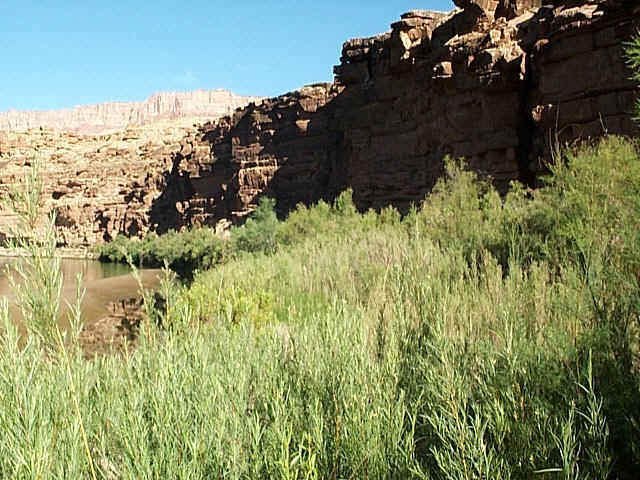



Beaver habitat and tracks downstream of the Glen Canyon Dam (Ostapuk)
Excerpts from the book "The Colorado River Through the Grand Canyon:
Natural History and Human Change", Steven W. Carothers and Bryan T. Brown
"Riverine habitat for beaver along the mainstem river was not always as favorable as it is today. Vernon O. Bailey made the only scientific observation on the pre-dam status of the beaver in the river when he observed in 1935 that, in general, there were "few suitable places for them and little suitable food". Annual spring floods apparently created unstable conditions for beaver in the river, as well as scouring away seedlings and saplings of their preferrred foods, cottonwood and willow trees. Sizeable beaver populations have probably always been found along the larger and more heavily vegetated tributaties, especially Bright Angel and Havasu Creeks.
The beaver population apparently began to expand after the completion of Glen Canyon Dam in 1963. This increase in numbers is probably attributable to a combination of factors, including an end to pre-dam spring floods and the post-dam development of extensive riprarian vegetation. A November 1977 census in lower Marble Canyon revealed four beaver burrows in a 3-mile reach of the river. A conservative estimate of a least two beaver per burrow indicates eight beaver in the 3-mile reach, or 2.67 beaver per mile of river. This density is probably representative of beaver populations in the late 1970s in areas where stands of coyote willow provide suitable food.
Unlike their relatives who build dams and lodges on smaller streams, beaver in Grand Canyon build stick lodges against or on a heavily vegetated beach or else burrow into the banks of the river. The burrow entrance, usually below the average high water line, leads upward to a small excavated room. Suitable for one or more adult beaver, the room provides a dry refuge in which the young are raised."
Excerpts from the book "Down Canyon: A Naturalist Explores the
Colorado River through the Grand Canyon", Ann Haymond Zwinger
"Farther down the beach a dark thicket pushes right to the water's edge. After crabbing my way through some twenty feet of thicket, I suddenly come upon a well-traveled beaver passageway down to the river, grass broken and packed down, overlaid with sand, not as smooth as a slide but clearly well trafficked.

The spring spates [floods] of the pre-dam river limited beaver populations. They [the floods] decimated the riprarian vegetation that is the beavers' main food supply and [the floods] often drowned young beavers in their dens. Now the calmer post-dam waters have allowed more young to mature and a 1977 census suggests a solid population in Marble Canyon.
Stream beavers build lodges and dams and assiduously maintain them but beavers along the Colorado River den deep into the vegetation at the edge of the river or burrow into the river banks. I turn left and pad up the beaver runway under a ceiling of thatch. Thumb-sized willow stems gleam, cleanly cut on a slant a few inches off the ground. The alley narrows and fallen branches, caught knee-high, blockade the passage like a series of sawhorses. Thwarted, I stop thinking like a human and begin thinking like a beaver, drop down on hands and knees, crawl, and finally squirm through on my stomach...[where] I reach a cul-de-sac and can sit up.
At least two dozen trees fell to create this little clearing and from it, trails fizzle out in every direction deeper into the thicket. If a beaver were to look up, it would see fluffy seed heads of grass and feathery boughs of tamarisk and a sky filtered through crosshatched leaves of reed and willow. Pretty nice digs if you're a beaver."
Peregrine Fund field notes on theVermillion Cliffs Condor Release Program - October 1999.
"The latest natural foraging was reported by Kelly Vickrey on October 3rd. After hiking down to the Colorado River via Soap Canyon, Kelly observed a dead beaver floating in the river at the confluence of Soap Creek and the Colorado. What Kelly observed the next morning was even more unexpected. Approximately ¼ mile down stream Condors 19, 23, 27, and 36 were at the water’s edge on the west bank of the river feeding on what Kelly speculates was the dead beaver. This observation, while unconfirmed, represents the second time the condors have been observed feeding on a beaver along this section of river. Last January, Condors 24, 27, and 34 fed on a beaver carcass at Badger Canyon just three miles upstream. "
Beaver Dams improve habitat - (Arizona Daily Star 5/29/2000)
Experts believe recolonizing the San Pedro area will improve the habitat for other animals and cause more water to seep into the underground aquifer.
"Beaver dams allow the water to flow into the stream bank during the cool season and feed back out when it gets hotter, so you get more water flow in the summertime," said Mark Fredlake, a biologist at the U.S. Bureau of Land Management's office in Sierra Vista. The agency and the Arizona Game and Fish Department are overseeing the reintroduction program.
Also, by creating marshy areas and more complex channels that slow the San Pedro's flow, dams can help prevent flooding, said Kieran Suckling, executive director of the Tucson-based Center for Biological Diversity. With just a linear path, he said, the water can "blast straight through."
Hmmm......for a while there I though they were talking about Glen Canyon Dam!
References:
Steven W. Carothers and Bryan Y. Brown, "The Colorado River Through Grand Canyon -
Natural History and Human Change"(Tucson: The University of Arizona Press, 1991).
Ann Haymond Zwinger, "Down Canyon - A Naturalist Explores the Colorado River
through the Grand Canyon", (Tucson: The University of Arizona Press, 1995).
On Line: Peregrine Fund Field Notes, Vermillion Cliffs Condor Release Experiment, October 4-10, 1999, http://www.peregrinefund.org/notes_condor.html